A Day Trip to Auschwitz & Birkenau
Took an early public bus (7.50am) from Krakow to Auschwitz. The journey was 1.5hrs.
That's our mini bus to the biggest Nazi concentration camp for Poles & prisoners from other countries.

The road to the camp was a quite a scenic wan.

We got hungry easily in winter, so we decided to have something in our bag to munch on.
And this is the most romantic option, isn't it? hee...

We joined the english tour, and were scheduled to watch an introductory movie before we proceeded to meet our tour guide.
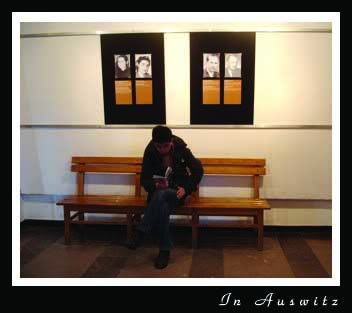
As we started our tour, our tour guide prepared us to view the gigantic and horrific factory of death...He was solemn as he explained and described the various sites and exhibits.
The camp established in 1940, had a main gate where the prisoners passed each day on their way to work (returning 12 hours or more later). Above the gate read, "Arbeit Macht Frei", which means "Works bring freedom". This actually gave the prisoners a false impression that they can be freed as they work harder....

During roll-calls, the SS counted the prisoners and carried out executions on the portable gallows or on the collective gallows as a reconstruction of which can be seen in the foto below. On July 1943, twelve Poles were hanged here for having contacts with civilians outside the camp, and for assisting in the escape of three fellow prisoners. It also acted as a warning to the rest of the prisoners..

The execution wall. Here, the prisoners were executed. Before they were shot, all the victims were made to undress.....windows facing the execution wall were blocked from seeing what was happening.

Next to the execution wall, there are portable gallows to hang the prisoners....Notice the windows...

As our tour guide finished Auschwitz tour, we proceeded to Birkenau, 3km from the Aushwitz.
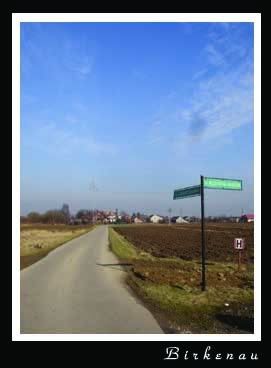
Very scenic place. Thank God the sky was blue. Beautiful.
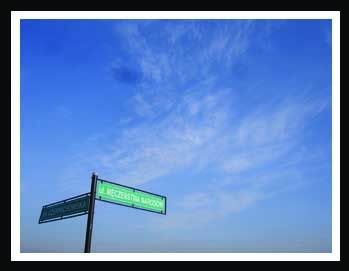
The Birkenau consist of 300 buildings. Of these, 45 made of brick and 22 of wood have survived almost intact. In the places where the other buildings previously stood (these were either burnt down or demolished) only the hearths remain.
Our solemn english tourguide...

As we stood outside the Birkenau camp, we can still see the railway tracks, leading directly INTO the camp! I can imagine the scene when the jewish were deported into the camp, unloaded and examined on the spot by the SS physicians. Those selected for work were spared life (for a while maybe), while the others were sent to the gas chambers immediately...most without registration and without identification. Those headed to the gas chambers were assured by the SS that they would be allowed a bath. They are told to undress, after which they were herded into the underground chamber resembling a bathroom. Showers were fitted to the ceiling -- but they were never connected to the water supply. After the doors had been firmly closed, SS men would poured the substance Cyclon B into the chamber thru special openings in the ceiling. Within 15-20mins the pple trapped inside died. Their gold tooth fillings,rings, ear-rings, and also their hair had been removed from the bodies, and then taken into incinerators situated just nearby.
The hair, glasses, briefcases, shoes, combs and etc, are now permanent exhibits in Auschwitz camp. Believe me, as I stood there watching the mountains of exhibits, my hair stand.... =(
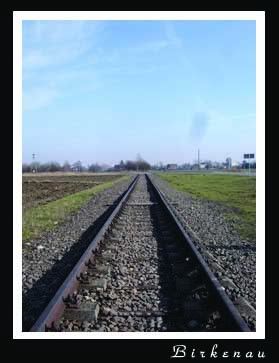
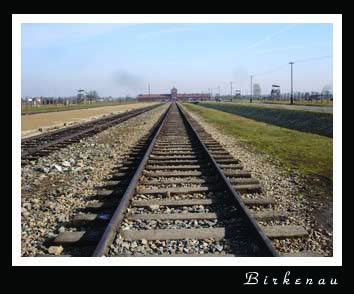

In Birkenau, we have the opportunity to view the prisoners' living quarters as they really were. They were built without foundations, directly on the swampy ground. Most of them had no floor at all, apart from the compressed earth. The brick barracks housed the women prisoners, who slept on three-tier berths spread over with rotting straw. One one level, an average of 8 persons would lie....
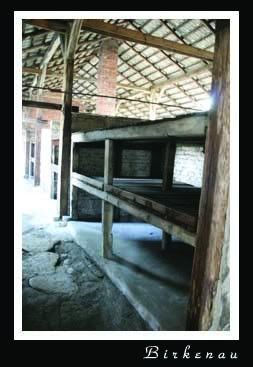
The memorial that reads "Forever let this place be a cry for despair, and a warning for humanity, where the Nazis murdered about one and a half million men, women, children, mainly Jews from various countries of Europe."
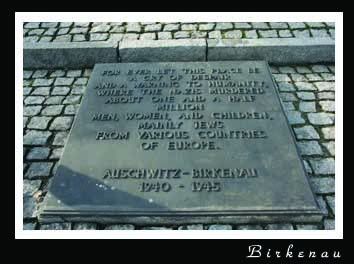
This is the remains of the underground gas chambers, blown up by the retreating SS men in an attempt to conceal their criminal activities. In the ruins, it is still possible to discern the underground changing room, where the victims were made to undress and the gas chambers.
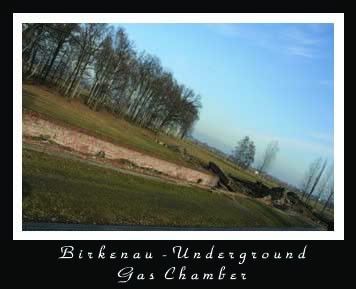
We finished the guided tour altogether, and got ourselves transported back to Auschwitz to revisit the exhibits...
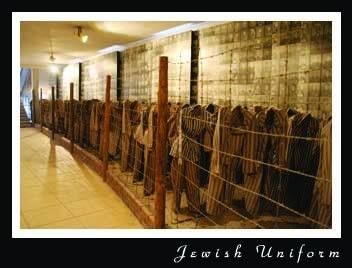
Along the corridor, the fotos of the Jewish prisoners who lost their life in the camp.....looking at you as u walk past them.... =(

The crematorium. Here prisoners sent into the chambers were told to undress right outside the door. It is a disgrace to the female prisoners.

And do u noe, what the prisoners ate for their three meals per day?
1) For breakfast, they would receive 1/2 litre of imitation coffee and for dinner 1 litre of meatless soup, often cooked with rotten vegetables. Supper consisted of 300-350gramms of black clayey bread, 30g of margarine, 20g of sausage and some herbal tea or "coffee".
We left the camp as the in-charge chased us out, the camp closed it doors to visitors at 3pm in winter.
This day trip to the state musuem in Aushwitz is an eye-opener for us. I count my blessings that I am able to stand there in the camp and view the remaining exhibits today.
If you go, pls, heed their advise, and behave appropriately, respecting the memory of those who suffered and died there....
That's our mini bus to the biggest Nazi concentration camp for Poles & prisoners from other countries.

The road to the camp was a quite a scenic wan.

We got hungry easily in winter, so we decided to have something in our bag to munch on.
And this is the most romantic option, isn't it? hee...

We joined the english tour, and were scheduled to watch an introductory movie before we proceeded to meet our tour guide.

As we started our tour, our tour guide prepared us to view the gigantic and horrific factory of death...He was solemn as he explained and described the various sites and exhibits.
The camp established in 1940, had a main gate where the prisoners passed each day on their way to work (returning 12 hours or more later). Above the gate read, "Arbeit Macht Frei", which means "Works bring freedom". This actually gave the prisoners a false impression that they can be freed as they work harder....

During roll-calls, the SS counted the prisoners and carried out executions on the portable gallows or on the collective gallows as a reconstruction of which can be seen in the foto below. On July 1943, twelve Poles were hanged here for having contacts with civilians outside the camp, and for assisting in the escape of three fellow prisoners. It also acted as a warning to the rest of the prisoners..

The execution wall. Here, the prisoners were executed. Before they were shot, all the victims were made to undress.....windows facing the execution wall were blocked from seeing what was happening.

Next to the execution wall, there are portable gallows to hang the prisoners....Notice the windows...

As our tour guide finished Auschwitz tour, we proceeded to Birkenau, 3km from the Aushwitz.

Very scenic place. Thank God the sky was blue. Beautiful.

The Birkenau consist of 300 buildings. Of these, 45 made of brick and 22 of wood have survived almost intact. In the places where the other buildings previously stood (these were either burnt down or demolished) only the hearths remain.
Our solemn english tourguide...

As we stood outside the Birkenau camp, we can still see the railway tracks, leading directly INTO the camp! I can imagine the scene when the jewish were deported into the camp, unloaded and examined on the spot by the SS physicians. Those selected for work were spared life (for a while maybe), while the others were sent to the gas chambers immediately...most without registration and without identification. Those headed to the gas chambers were assured by the SS that they would be allowed a bath. They are told to undress, after which they were herded into the underground chamber resembling a bathroom. Showers were fitted to the ceiling -- but they were never connected to the water supply. After the doors had been firmly closed, SS men would poured the substance Cyclon B into the chamber thru special openings in the ceiling. Within 15-20mins the pple trapped inside died. Their gold tooth fillings,rings, ear-rings, and also their hair had been removed from the bodies, and then taken into incinerators situated just nearby.
The hair, glasses, briefcases, shoes, combs and etc, are now permanent exhibits in Auschwitz camp. Believe me, as I stood there watching the mountains of exhibits, my hair stand.... =(



In Birkenau, we have the opportunity to view the prisoners' living quarters as they really were. They were built without foundations, directly on the swampy ground. Most of them had no floor at all, apart from the compressed earth. The brick barracks housed the women prisoners, who slept on three-tier berths spread over with rotting straw. One one level, an average of 8 persons would lie....

The memorial that reads "Forever let this place be a cry for despair, and a warning for humanity, where the Nazis murdered about one and a half million men, women, children, mainly Jews from various countries of Europe."

This is the remains of the underground gas chambers, blown up by the retreating SS men in an attempt to conceal their criminal activities. In the ruins, it is still possible to discern the underground changing room, where the victims were made to undress and the gas chambers.

We finished the guided tour altogether, and got ourselves transported back to Auschwitz to revisit the exhibits...

Along the corridor, the fotos of the Jewish prisoners who lost their life in the camp.....looking at you as u walk past them.... =(

The crematorium. Here prisoners sent into the chambers were told to undress right outside the door. It is a disgrace to the female prisoners.

And do u noe, what the prisoners ate for their three meals per day?
1) For breakfast, they would receive 1/2 litre of imitation coffee and for dinner 1 litre of meatless soup, often cooked with rotten vegetables. Supper consisted of 300-350gramms of black clayey bread, 30g of margarine, 20g of sausage and some herbal tea or "coffee".
We left the camp as the in-charge chased us out, the camp closed it doors to visitors at 3pm in winter.
This day trip to the state musuem in Aushwitz is an eye-opener for us. I count my blessings that I am able to stand there in the camp and view the remaining exhibits today.
If you go, pls, heed their advise, and behave appropriately, respecting the memory of those who suffered and died there....
